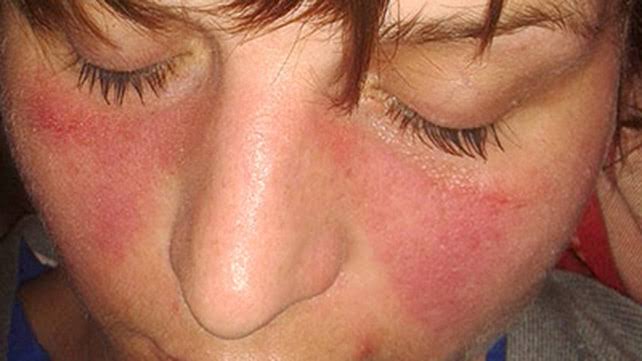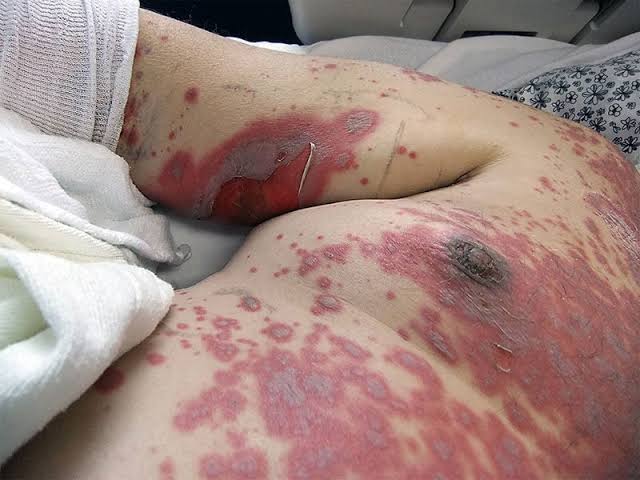Systemic Lupus Erythematosus (SLE);

Introduction to SLE
Systemic Lupus Erythematosus (SLE) is a chronic autoimmune disease characterized by a dysregulated immune response, resulting in inflammation and damage to various organs and tissues throughout the body. This condition can be debilitating, affecting multiple systems and often posing challenges in diagnosis and management.
Cause of SLE:
Systemic Lupus Erythematosus (SLE) is a complex autoimmune disease with a multifactorial etiology. While the exact cause of SLE remains unknown, several factors contribute to its development. Here are some key factors implicated in the pathogenesis of SLE:
- Early Complement Deficiency: Deficiencies in early components of the complement system, such as C1q, C2, and C4, have been associated with an increased risk of developing SLE. Complement deficiencies can impair the clearance of immune complexes and apoptotic cells, leading to dysregulated immune responses and autoantibody production.
- Genetic Predisposition: Genetics play a significant role in the development of SLE. Individuals with a family history of SLE or other autoimmune diseases are at a higher risk of developing the condition. Multiple genes have been implicated in SLE susceptibility, including those involved in immune system regulation, apoptosis (cell death), and the production of autoantibodies.
- Environmental Triggers: Environmental factors, such as exposure to ultraviolet (UV) light, certain medications, infections, and hormonal factors, can trigger or exacerbate SLE in genetically predisposed individuals. UV light exposure, in particular, is known to induce skin lesions and worsen systemic symptoms in people with SLE.
- Abnormal Immune Response: SLE is characterized by dysregulation of the immune system, leading to the production of autoantibodies and immune complex deposition in various tissues and organs. Abnormalities in immune cell function, including B cells, T cells, and dendritic cells, contribute to the pathogenesis of SLE. Dysfunction in the clearance of apoptotic cells also plays a role in triggering an autoimmune response.
- Hormonal Factors: Hormonal factors, particularly estrogen, have been implicated in the development and exacerbation of SLE, as the condition disproportionately affects women of childbearing age. Estrogen is known to modulate immune responses and promote B cell activation, potentially contributing to the autoimmune process in susceptible individuals.
- Epigenetic Modifications: Epigenetic changes, such as alterations in DNA methylation, histone modifications, and microRNA expression, have been observed in individuals with SLE. These epigenetic modifications can influence gene expression and immune cell function, contributing to the development and progression of SLE.
- Dysregulation of Interferon Pathways: Aberrant activation of the type I interferon (IFN) pathway has been implicated in the pathogenesis of SLE. Increased production of type I IFNs, along with dysregulation of downstream signaling pathways, leads to immune cell activation, inflammation, and tissue damage in SLE.
- Microbial Triggers: Infections, particularly viral infections like Epstein-Barr virus (EBV) and cytomegalovirus (CMV), have been proposed as potential triggers of SLE in genetically susceptible individuals. Molecular mimicry, where microbial antigens resemble self-antigens, can lead to cross-reactivity and the production of autoantibodies in SLE.
Overall, the development of SLE is likely influenced by a combination of genetic, environmental, hormonal, immunological, and epigenetic factors.
Pathogenesis of SLE:
Systemic Lupus Erythematosus (SLE) involves a complex interplay of immune dysregulation, leading to widespread inflammation and tissue damage. The mechanism of SLE encompasses several key processes:
- Immune Complex Formation and Deposition: In SLE, there is an overproduction of autoantibodies against self-antigens, such as nuclear antigens (e.g., DNA, RNA, histones, ribonucleoproteins). These autoantibodies form immune complexes when they bind to their corresponding antigens. These immune complexes can deposit in various tissues, including the kidneys, skin, joints, and blood vessels, triggering inflammation and tissue damage.
- Complement Activation: Immune complexes formed in SLE can activate the complement system, leading to the generation of complement components such as C3a, C4a, and C5a. Complement activation enhances inflammation and recruits inflammatory cells to the sites of immune complex deposition, exacerbating tissue damage.
- Aberrant B Cell Activation: B lymphocytes play a central role in the pathogenesis of SLE by producing autoantibodies against self-antigens. Dysregulated B cell activation and differentiation lead to the production of autoantibodies, including anti-double-stranded DNA (anti-dsDNA) antibodies and anti-Smith (anti-Sm) antibodies. These autoantibodies contribute to immune complex formation and tissue injury.
- T Cell Dysfunction: T lymphocytes, particularly CD4+ T cells, are involved in the pathogenesis of SLE through their interactions with B cells and other immune cells. Aberrant T cell signaling and cytokine production contribute to the activation of B cells and the production of autoantibodies. Additionally, CD8+ cytotoxic T cells may contribute to tissue damage through direct cytotoxicity.
- Inflammatory Cytokines: Dysregulated cytokine production, including elevated levels of pro-inflammatory cytokines such as interleukin-6 (IL-6), tumor necrosis factor-alpha (TNF-α), and interferon-alpha (IFN-α), further amplify the inflammatory response in SLE. These cytokines promote immune cell activation, tissue inflammation, and organ damage.
- Defective Clearance of Apoptotic Cells: Impaired clearance of apoptotic cells, which leads to the release of self-antigens, contributes to the generation of autoantibodies and immune complex formation in SLE. Defective phagocytosis of apoptotic cells by macrophages and impaired function of complement components involved in apoptotic cell clearance may exacerbate autoimmunity.
Overall, the mechanisms of SLE involve a complex interplay of dysregulated immune responses, including immune complex formation, complement activation, aberrant B and T cell activation, cytokine dysregulation, and defective apoptotic cell clearance, ultimately leading to systemic inflammation and tissue damage.
Read Another Article: How to lose weight when you have heart disease?
Risk Factors for SLE
While anyone can develop SLE, certain factors increase the risk of developing the disease. Women are disproportionately affected, with SLE being more common in females of childbearing age. Additionally, individuals with a family history of autoimmune diseases, such as SLE, have a higher risk of developing the condition. Environmental factors, such as smoking, exposure to ultraviolet light, and certain infections, can also contribute to the risk of SLE.
Symptoms of SLE
Here’s a list of symptoms of Systemic Lupus Erythematosus (SLE) :
- Fatigue: Persistent fatigue that interferes with daily activities.
- Joint Pain and Swelling: Arthritis involving multiple joints, characterized by pain, stiffness, and swelling.
- Skin Rash: Butterfly-shaped rash across the cheeks and bridge of the nose (malar rash), photosensitivity, discoid rash (raised patches), and mucous membrane ulcers.
- Fever: Unexplained fever, often low-grade, especially during disease flares.
- Oral and Nasal Ulcers: Painful ulcers in the mouth or nose.
- Raynaud’s Phenomenon: Episodes of color changes in the fingers and toes (white, blue, or red), often triggered by cold or stress.
- Chest Pain: Pleurisy, inflammation of the lining of the lungs, causing chest pain exacerbated by deep breathing or coughing.
- Kidney Problems: Symptoms such as blood in the urine, foamy urine, swelling (edema), and high blood pressure.
- Neurological Symptoms: Headaches, seizures, cognitive dysfunction (“brain fog”), and mood disorders.
- Gastrointestinal Symptoms: Abdominal pain, nausea, vomiting, and diarrhea.
- Hair Loss: Thinning of the hair or hair loss (alopecia).
- Anemia: Low red blood cell count (anemia) leading to symptoms such as fatigue, weakness, and shortness of breath.
- Miscarriages: Increased risk of miscarriages and pregnancy complications in women with SLE.
These symptoms can vary in severity and may come and go over time.
Treatment of SLE
Treatment of Systemic Lupus Erythematosus (SLE) aims to control symptoms, prevent flare-ups, and minimize organ damage. It typically involves a combination of medication, lifestyle modifications, and regular monitoring by healthcare providers. Here’s an overview of the treatment approach:
- Nonsteroidal Anti-Inflammatory Drugs (NSAIDs):
- NSAIDs like ibuprofen and naproxen help relieve mild joint pain, stiffness, and fever associated with SLE.
- They are used on an as-needed basis to manage symptoms during flares.
- Corticosteroids:
- Corticosteroids, such as prednisone, are potent anti-inflammatory drugs used to suppress inflammation and reduce immune system activity.
- They are effective in managing moderate to severe symptoms of SLE, including joint pain, rash, and organ inflammation.
- Long-term use of corticosteroids is associated with significant side effects, so healthcare providers aim to minimize their dosage and duration.
- Immunosuppressive Drugs:
- Immunosuppressive medications, such as azathioprine, methotrexate, mycophenolate mofetil, and cyclophosphamide, are used to suppress the overactive immune response in SLE.
- They are often prescribed in combination with corticosteroids to achieve better disease control while minimizing corticosteroid dosage.
- These medications may be used for individuals with severe organ involvement or those who do not respond adequately to other treatments.
- Antimalarial Drugs:
- Hydroxychloroquine (Plaquenil) and chloroquine are antimalarial drugs that have been found to be effective in treating skin rashes, joint pain, and fatigue in SLE.
- They also have immunomodulatory properties and can reduce the risk of disease flares and organ damage.
- Antimalarials are often used as long-term maintenance therapy in individuals with mild to moderate SLE.
- Biologic Therapies:
- Biologic agents, such as belimumab (Benlysta), are targeted therapies that specifically inhibit components of the immune system involved in the pathogenesis of SLE.
- Belimumab, the first biologic drug approved for SLE, is administered intravenously and can be used in combination with other standard treatments.
- Biologic therapies may be considered for individuals with refractory disease or those who cannot tolerate conventional treatments.
- Lifestyle Modifications:
- Lifestyle modifications play a crucial role in managing SLE and reducing the risk of flares.
- Patients are advised to protect themselves from sun exposure by wearing sunscreen, protective clothing, and avoiding direct sunlight during peak hours.
- Regular exercise, a balanced diet, stress management techniques, and adequate rest are recommended to improve overall well-being and reduce inflammation.
- Regular Monitoring:
- Patients with SLE require regular monitoring by healthcare providers to assess disease activity, organ involvement, medication side effects, and response to treatment.
- Monitoring may involve routine blood tests, urine analysis, imaging studies, and clinical assessments to detect any changes in disease status and adjust treatment accordingly.
Treatment of SLE is individualized based on the severity of symptoms, the extent of organ involvement, and the patient’s overall health status. A multidisciplinary approach involving rheumatologists, dermatologists, nephrologists, and other specialists is often necessary to provide comprehensive care for individuals with SLE.
Complications of SLE:
SLE can lead to various complications, depending on the organs involved and the severity of the disease. Kidney involvement, known as lupus nephritis, is a significant complication and can progress to end-stage renal disease if left untreated. Cardiovascular complications, including pericarditis and accelerated atherosclerosis, contribute to increased cardiovascular morbidity and mortality in patients with SLE. Other complications may include neurologic manifestations, hematologic abnormalities (such as anemia and thrombocytopenia), and increased susceptibility to infections.
Summary:
Systemic Lupus Erythematosus is a complex autoimmune disease characterized by a dysregulated immune response and multi-organ involvement. While significant progress has been made in understanding the pathogenesis and management of SLE, many challenges remain in optimizing treatment outcomes and reducing the burden of disease for affected individuals. Through continued research and collaboration, advancements in diagnosis, treatment, and prevention hold the promise of improving the lives of those living with SLE.
Read Another Article: Health Benefits of Aparajita

